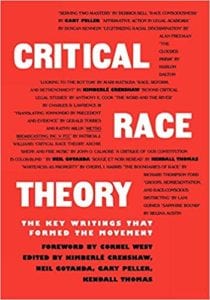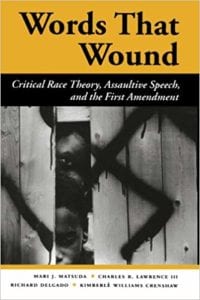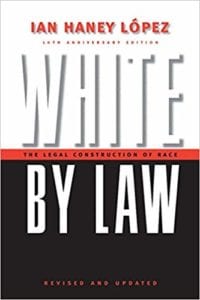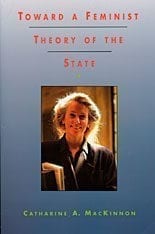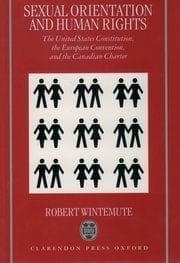Listed below are books written by our Center members, separated by publication year and alphabetically by author name.
Critical Race Theory: The Key Writings That Formed the Movement, 1996
Authors: Kimberle Crenshaw, Neil Gotanda, Gary Peller,
Publisher: The New Press
Language: English
About: In the past few years, a new generation of progressive intellectuals has dramatically transformed how law, race, and racial power are understood and discussed in America. Questioning the old assumptions of both liberals and conservatives with respect to the goals and the means of traditional civil rights reform, critical race theorists have presented new paradigms for understanding racial injustice and new ways of seeing the links between race, gender, sexual orientation, and class. This reader, edited by the principal founders and leading theoreticians of the critical race theory movement, gathers together for the first time the movement’s most important essays.
Words That Wound: Critical Race Theory, Assaultive Speech, And The First Amendment, 1993
Authors: Mari J.Matsuda, Charles R. Lawrence III, Richard Delgado, Kimberlè Williams Crenshaw
Publisher: Westview Press
Language: English
About: Words, like sticks and stones, can assault; they can injure; they can exclude. In this important book, four prominent legal scholars from the tradition of critical race theory draw on the experience of injury from racist hate speech to develop a first amendment interpretation that recognizes such injuries. In their critique of “first amendment orthodoxy,” the authors argue that only a history of racism can explain why defamation, invasion of privacy, and fraud are exempt from free-speech guarantees while racist and sexist verbal assaults are not.The rising tide of verbal violence on college campuses has increased the intensity of the “hate speech” debate. This book demonstrates how critical race theory can be brought to bear against both conservative and liberal ideology to motivate a responsible regulation of hate speech. The impact of feminist theory is also evident throughout. The authors have provided a rare and powerful example of the application of critical theory to a real-life problem.This timely and necessary book will be essential reading for those experiencing the conflicts of free-speech issues on campus—students, faculty, administrators, and legislators—as well as for scholars of jurisprudence. It will also be a valuable classroom tool for teachers in political science, sociology, law, education, ethnic studies, and women’s studies.
White by Law: The Legal Construction of Race, 1996
Authors: Ian Haney Lopez
Publisher: New York University Press
Language: English
About: Lily white. White knights. The white dove of peace. White lie, white list, white magic. Our language and our culture are suffused, often subconsciously, with positive images of whiteness. Whiteness is so inextricably linked with the status quo that few whites, when asked, even identify themselves as such. And yet when asked what they would have to be paid to live as a black person, whites give figures running into the millions of dollars per year, suggesting just how valuable whiteness is in American society.
Exploring the social, and specifically legal origins, of white racial identity, Ian F. Haney Lopez here examines cases in America’s past that have been instrumental in forming contemporary conceptions of race, law, and whiteness. In 1790, Congress limited naturalization to white persons. This racial prerequisite for citizenship remained in force for over a century and a half, enduring until 1952. In a series of important cases, including two heard by the United States Supreme Court, judges around the country decided and defined who was white enough to become American.
White by Law traces the reasoning employed by the courts in their efforts to justify the whiteness of some and the non- whiteness of others. Did light skin make a Japanese person white? Were Syrians white because they hailed geographically from the birthplace of Christ? Haney Lopez reveals the criteria that were used, often arbitrarily, to determine whiteness, and thus citizenship: skin color, facial features, national origin, language, culture, ancestry, scientific opinion, and, most importantly, popular opinion.
Having defined the social and legal origins of whiteness, White by Law turns its attention to white identity today and concludes by calling upon whites to acknowledge and renounce their privileged racial identity.
Toward a Feminist Theory of the State, 1991
Authors: Catharine A. MacKinnon
Publisher: Harvard University Press
Language: English
About: Toward a Feminist Theory of the State presents Catharine MacKinnon’s powerful analysis of politics, sexuality, and the law from the perspective of women. Using the debate over Marxism and feminism as a point of departure, MacKinnon develops a theory of gender centered on sexual subordination and applies it to the state. The result is an informed and compelling critique of inequality and a transformative vision of a direction for social change.
Sexual Orientation and Human Rights: The United States Constitution, the European Convention, and the Canadian Charter, 1997
Authors: Robert Wintemute, Mads Andenas
Publisher: Oxford University Press
Language: English
About: Lesbian and gay rights are human rights!” Is this just a political slogan to be chanted outside legislatures, or are there legal arguments to support the claim that the right to be free from sexual orientation discrimination is a human right? In particular, can national constitutions or international human rights treaties be interpreted as prohibiting discrimination against gays, lesbians, and bisexuals? Robert Wintemute attempts to answer these questions by examining three of the most commonly used arguments in favor of such an interpretation: sexual orientation is an “immutable status”, sexual orientation is a “fundamental choice” (or part of “privacy”), and sexual orientation discrimination is sex discrimination. To assess their merits, he looks at the relative success and failure in cases argued under three of the world’s most influential human rights instruments: the United States Constitution, the European Convention on Human Rights, and the Canadian Charter of Rights and Freedoms. He also considers the potential impact of the United Nations Human Rights Committee’s recent interpretation of the International Covenant on Civil and Political Rights in Toonen v. Australia.
